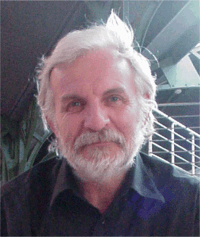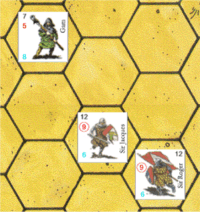Gary Chalk is the "genius" who invented Cry Havoc in the early 80’s.
As an illustrator, he designed the maps and playing pieces,
while the rules were co-written with
Tony Webster.
After a long quest, I have been able to get in touch with
him from Las Vegas, while he was in Normandy!
Buxeria: Gary, you made my day in accepting to answer
these few questions.
Gary Chalk: You're in naughty Las Vegas, I'm sitting in
freezing Normandie and my email made your day? You should
get out more.... Joking aside, it's really great to have
such a warm response!
B: I've been in Vegas too often over the last 15 years
to still get excited
by Sin City, and having an interaction - yet virtual - with
the man who invented a game that has been inspiring me these
last 25 years is really a thrilling experience. Now let's
get back to Cry Havoc: This game had
|
 |
quite a few ground-breaking concepts that definitely
participated to its longevity: Outstanding artwork,
differentiated characters (names, outfits, weapons, etc.),
game scale. How did you come up with these?
G.C.: I came up with the concept of Cry Havoc because as a
figure gamer who had begun to play board wargames, I was
genuinely appalled by the design of the products on offer at
the time. I couldn’t understand why gamers were prepared to
spend hours pushing tiny squares of khaki and field grey
card across mud- coloured maps. I thought that there must be
a more exciting way to design a wargame and set out, with
all the confidence of youth, to do just that.
I decided to use named individuals, as these seemed to be
about as far from the sludge green counters marked “3rd
Shock Army” as I could reasonably be expected to get.
Likewise I settled on the medieval era as it was extremely
colourful, with varied weapons, larger than life characters
and an ambiance somewhere between a wargame and roleplaying.
Not a serious simulation. Not a well-reasoned examination of
the feudal system.
B: There is still a lot of discussion within the Cry
Havoc community about the combat table when the odds are
1:1. It seems to be way too unfavorable to the attacker. Is
there any reason behind it?
| Cry Havoc was meant to be FUN!!!
This is why combats at 1:1 odds are indecisive. The
evenly matched Sir Jacques and Sir Roger are
supposed to clash swords, sway backwards and
forwards a couple of time before some ghastly
peasant nips round the back and sticks his pitchfork
into sir Jacques’ sensitive regions, thus changing
the odds and bringing the combat to a sad end.
As it was meant to be fun, I didn’t worry about
market research or looking around for better ideas.
After Tony Webster and I had worked out the rules
together, I just sat down and did it. So, if there’s
anything in Cry Havoc you don’t like, please feel
free to change it.
B: Any secret story about the origin of the
various character names? |
 |
G.C.: The names for the characters were chosen at random
from any medieval names I could find in reference books
dealing with the period.
B: Do you still have any sketches of unpublished
characters or maps that you could share with me?
G.C.: Unfortunately I don’t have any sketches or notes
left from this time. As an illustrator, if I kept all my
sketches and notes, I would now be waist deep in paper.
B: Foot soldiers are fairly stocky and almost look
like dwarves. Was it intentional, to cope with the square
size of the counter or just an artistic choice? Also,
representing characters from the back was quite a bold move.
How did you come up with this idea?
|
G.C.: The characters are
a little on the short and stocky side, but then
people generally are. Few people are tall and
elegant in real life. The type of person you see in
a tv advert is rarely seen on the street. Also, the
shorter the character, the more room I had to fit in
the top of a spear or a polearm. I also tried to
make them looked varied by using lots of different
colors |
 |
and showing people from the back,
the side and so on. I wanted to make them feel as much like
25mm wargames figures as was possible and indeed would have
loved to have produced figures to use on the maps.
B: Let's chat about the maps: Why did you come up with
a yellow color to represent the flat terrain, while the
grass of England is pretty green :-) Also, I'm still trying
to find the actual crossroad on the map with the same name:
Why such a name?
|
G.C.: I wanted the maps
to be colourful and settled on the sandy yellow base
colour as something that would be useable just about
anywhere in the world. If it was grass green, it
wouldn’t look right in a desert etc. I had vaguely
thought of a crusades variant and so the yellow
seemed a good choice. The names, such as the
Crossroads were put on the maps to |
 |
differentiate them one from
the other rather than cold, dull numbers. After all these
years I will finally own up that there is, in fact no
crossroads on the map of that name. Guilty as charged.
B: What is your feeling to see your creation still
being praised, played and expanded 30 years later? If you
were to reinvent the game today, what would you do
differently?
G.C.: I’m amazed that the game is still played and is so
popular today. If I were to reinvent it today I would make
sure that this time I actually made some money out of it! In
fact I discovered that my partners in the enterprise, who
were a pair of printers, had enormous financial problems
that they had not told me about. I couldn’t get any
cooperation on how to take the game forward, there was no
money to invest and I was finally forced to leave Standard
Games in order to make a living. What exactly happened next
and who produced what I don’t know. I was too busy keeping
the wolf from the door.
However I had become a game designer and went on next to
work for Games Workshop, where I worked on the original
version of Talisman and designed Battlecars and Battlebikes
as well as doing loads of illustration for them. This was
before the company turned to the Dark Side of the Force and
still wanted to produce interesting games on any number of
subjects. The rest is history and I became a man with a
great future behind him!
B: Finally, what are you working on today, what is
your next project?
G.C.: At present I’m busily writing and illustrating
children’s books, although I would love to produce some more
Cry Havoc style games. In fact, I’m actually working on
something that strongly resembles the same concept, taken
forward into the gunpowder age. Anyone out there for
Pirates, Last of the Mohicans and or Napoleonic skirmish
warfare? Named counters, of course, with even better hex
maps and a rather cunning command control system. In spite
of the wrinkles, I feel ready for a new gaming challenge. If
you all like the sound of this, I might even see what I can
do about those controversial 1:1 odds on the Combat Results
table…
B: Thank you so much, Gary, for your insight. Let me
extend a warm thank you from the entire Cry Havoc community! |
